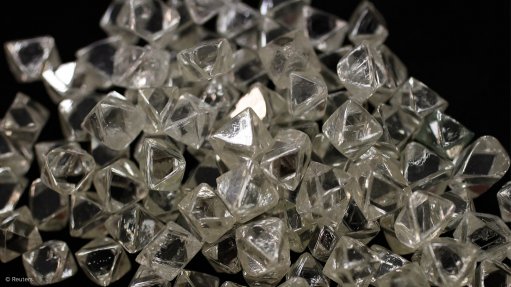
Photo by: Reuters
VANCOUVER (miningweekly.com) – Absent any significant global economic disturbances disrupting consumer diamond demand, incremental year-on-year diamond production declines are forecast to drive real diamond prices up by about 10% cumulatively from 2018 through 2021, or 17% in nominal terms, a new report by independent analyst Paul Zimnisky states.
Further, supporting supply dynamics favourable to prices, excess producer inventories have been reduced to multiyear lows and excess production capacity of the major producers is expected to be insufficient to significantly offset the pending supply gap, he says.
“If the above scenario plays out, diamond prices could revert back to 2014 levels, which would be about 8% above today’s prices. This would mark a significant price level for diamond producers, as in 2015, all five standalone publicly-traded diamond miners at the time were profitable and paid dividends on the back of 2014 diamond prices,” he stated.
According to Zimnisky, indications of the current supply-demand dynamic can already be seen as rough prices are up 3.9% year-to-date, through to mid-May, marking a 52-week high.
He explained that, following the global financial crisis of 2007 to 2009, diamonds were one of the fastest commodities to recover, up almost 150% from the low in early-2009 through mid-2011. The crisis resulted in curtailed diamond production just as incremental demand for diamonds was escalating, primarily a result of the Chinese market adopting the tradition of giving diamond engagement rings in the midst of the financial liberation of the nation’s middle and upper-middle class.
However, since hitting an all-time high in the second quarter of 2011, diamond prices have been in a prolonged downtrend as the run-up in prices led to growth in incremental supply through 2017, which was not met with commensurate demand, he noted. “This was in part due to China suffering an economic slowdown in 2015, and over-leveraging in the diamond industry’s manufacturing segment, which damaged industry sentiment and confidence while evoking unsettling price volatility.”
Today, the analyst noted, while the industry still deals with challenges ranging from shorter-term lender confidence in the Indian manufacturing segment, to longer-term fundamental shifts in consumer preferences for material luxury goods, forecast industry fundamentals point to an environment favouring higher diamond prices over a period of at least the next four years, he said.
Zimnisky added that diamond demand is correlated with global gross domestic demand growth and a current coordinated environment of global economic growth recently seen in the fourth quarter of 2017 and the March quarter this year, have translated to strong consumer sentiment and retail sales, especially in the industry’s most important markets.
The analyst’s data pointed to jewellery sales rising 11.9% year-on-year in the US during the first quarter, and in Mainland China gold, silver and jewellery retail sales were up 7.9%. The US represents the world’s largest end-market for diamond jewellery, at almost 50%, while greater China, which includes Mainland China, Hong Kong, Macau and Taiwan, is second, approaching 20%, the analyst pointed out.